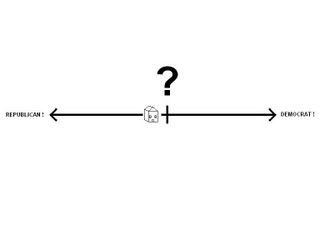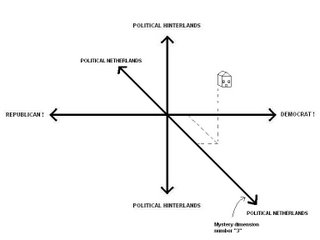Well, what fucking good does that do me? Who the fuck do I vote for, Mickey Mouse? No one? Why is a seemingly straight-forward thinking individual finding it so hard to classify himself into one of the two ruling parties?
The problem with the political continuum model is that it assumes two things:
1. Party platforms do not shift, and
2. There are only two parties.
The biggest problem is #2, where there is a giant grey cloud which encompasses a huge amount of people left wondering why they don't feel they are properly represented by either of the two ruling parties' ideologies.
Well, that's because political ideology isn't projected onto a 1-dimensional line between "Democrat" and "Republican."
 To the chagrin of many pundits, public figures, op/ed columnists, and radio/television personalities, in reality there is a vast "second dimension," or "second axis" of political thinkery on which one's political ideology may traverse, both in the positive and negative directions. I know it's hard to comprehend, but wayward minds may, actually, naturally tend to roam off the stable Democrat-Republican bilateral axis and into this danger zone of heterogeneity.
To the chagrin of many pundits, public figures, op/ed columnists, and radio/television personalities, in reality there is a vast "second dimension," or "second axis" of political thinkery on which one's political ideology may traverse, both in the positive and negative directions. I know it's hard to comprehend, but wayward minds may, actually, naturally tend to roam off the stable Democrat-Republican bilateral axis and into this danger zone of heterogeneity. My theory is that the less publicly understood, and therefore heretical, political affiliations lie somewhere in the solution space provided by my new dimension. There may even be a mysterious dimension number "3" to add to this mess, but I'd hate to trouble your mind with such complex algorithms.
My theory is that the less publicly understood, and therefore heretical, political affiliations lie somewhere in the solution space provided by my new dimension. There may even be a mysterious dimension number "3" to add to this mess, but I'd hate to trouble your mind with such complex algorithms. After all is said and done, why is it we have been stuck with the same two parties for over 80 years that have oscillated between positions of leadership and humiliation and scandal? Why is the country so entrenched in the two-party system? Is it because we are somehow coerced into projecting every possible viewpoint for every possible issue onto a 1-dimensional continuum, thereby losing differentiation and committing ourselves to a cycle of incapability and misrepresentation? Or is it because the structure of government or laws provide the path of least resistance necessary for the extended dominance of a two-party structure? You tell me.
After all is said and done, why is it we have been stuck with the same two parties for over 80 years that have oscillated between positions of leadership and humiliation and scandal? Why is the country so entrenched in the two-party system? Is it because we are somehow coerced into projecting every possible viewpoint for every possible issue onto a 1-dimensional continuum, thereby losing differentiation and committing ourselves to a cycle of incapability and misrepresentation? Or is it because the structure of government or laws provide the path of least resistance necessary for the extended dominance of a two-party structure? You tell me.

1 comment:
those charts and graphs remind me of Calculus, so they are terrifying and confusing to me.
Post a Comment